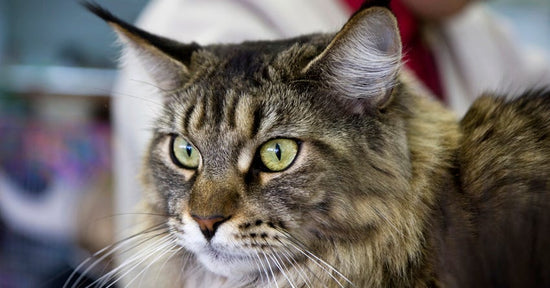Why Do Cats Get Hairballs and How Can Food Help?

As a pet lover, it can be concerning to see your beloved feline friend struggling with hairballs. These pesky little clumps of fur can be uncomfortable for your cat and stressful for you as a pet owner. But fear not, there are ways to help your cat with hairballs, and one of the key factors in managing this issue is the food that they eat. In this blog post, we will explore why cats get hairballs, when to be concerned about them, natural ways to help your cat, and how the right food can make a significant difference in hairball management.
Understanding Why Cats Get Hairballs
Hairballs might seem like a peculiar part of cat ownership, but there's a perfectly natural explanation for why our feline friends occasionally cough them up. Cats are meticulous groomers, dedicating a significant portion of their day to cleaning their coats. In fact, up to 2/3rds of a cat's shed hair can be ingested as they self-groom. Their tongues, uniquely designed with backward-facing barbs, act like a comb, catching loose and dead fur. While most of this fur passes harmlessly through the digestive system, some of it stays in the stomach, gradually accumulating into what we know as a hairball.
Cats can't digest fur. Over time, the accumulated fur needs to exit the body, and the most common way is through vomiting. This might not be the most pleasant aspect of cat care, but it's a natural consequence of their self-cleaning habits. Hairballs become more frequent in senior cats , and are more common in long-haired breeds and during warmer seasons when cats shed more. It's their body's way of saying, "I've got a bit too much fur in here; time to get it out!"
Understanding this process is the first step in supporting our furry companions. It's a sign of their cleanliness and dedication to grooming, even if it does result in the occasional hairball. Knowing this, we can appreciate the natural mechanisms at work and focus on ways to assist our pets in managing this hairy situation.
When to Be Concerned About Your Cat's Hairballs
While hairballs are a common and often harmless part of a cat's life, there are moments when they can signal something more worrisome. It's essential to stay observant and recognize when hairballs move from being a normal grooming byproduct to a sign of potential health issues. The typical amount of time between hairballs is a couple of weeks. If your cat is producing hairballs more frequently than usual or if you notice any changes in their behavior or physical well-being in conjunction with hairball expulsion, it's time to take a closer look.
Watch out for symptoms such as persistent gagging, retching without producing a hairball, a noticeable decrease in appetite, or signs of lethargy. These could be indicators that the hairballs are causing discomfort or that there's an underlying issue that needs professional attention. Similarly, if your cat seems to be struggling or in distress when trying to expel a hairball, this could suggest a blockage or other gastrointestinal troubles.
In particular, frequent hairball issues might also be accompanied by changes in the litter box, such as irregular bowel movements or signs of diarrhea or constipation. These symptoms can point to digestive issues that are making it harder for your cat to pass hair naturally through their system.
Remember, while it's normal for cats to have hairballs occasionally, a significant increase in frequency or any accompanying health concerns should prompt a visit to the vet. Your veterinarian can assess your cat's condition, rule out serious health problems, and provide guidance on how to reduce hairball formation through grooming practices, hydration, and dietary choices. Keeping an eye on these signs and acting promptly can ensure that your cat remains happy, healthy, and hairball-free.
Natural and Effective Ways to Help Your Cat with Hairballs
Tackling hairballs doesn't have to be a fur-raising experience! In fact, with some simple, natural strategies, you can effectively support your cat in managing these pesky fur clumps. Let's dive into a few approaches that are not only easy to implement but can make a world of difference in your cat's life.
Firstly, regular grooming is a game-changer. By brushing your cat more often, you're taking action to remove loose fur before your kitty swallows it during their self-grooming sessions. This can significantly reduce the amount of hair that accumulates in their stomach, thus minimizing hairball formation. Whether your cat has short or long fur, a gentle brushing routine can be a bonding experience for both of you, plus it keeps their coat looking sleek and shiny.
Hydration is another key factor. Ensuring that your cat has constant access to fresh, clean water can help keep their digestive system running smoothly. Hydrated fur is easier to pass through the intestinal tract, reducing the chances of it balling up in the stomach. You might even consider introducing a pet fountain to encourage your cat to drink more water, as many cats are enticed by moving water.
Diet plays a pivotal role in managing hairballs. Integrating high-fiber foods into your cat’s diet can aid in the movement of hair through the digestive tract. Foods rich in fiber help to create a smoother passage for hair, making it less likely to clump together and form hairballs. Incorporating moist foods into their diet can also promote hydration and facilitate the natural elimination of hair.
Lastly, there are specialized hairball remedies and supplements designed to help. These can lubricate the swallowed hair, easing its passage through the digestive system. However, it's essential to consult with your vet before introducing any new supplements to your cat's diet to ensure they're safe and suitable for your furry companion.
By integrating these natural and effective strategies into your routine, you're taking proactive steps to help your cat with hairballs. Each approach offers a simple way to support your cat's health and comfort, keeping both you and your feline happier.
The Impact of Food on Hairball Management
When it comes to helping your cat navigate the woes of hairballs, the role of their diet cannot be overstated. Opting for a diet that incorporates high-quality ingredients, abundant in essential nutrients, can significantly affect how effectively those unwanted hairballs are managed. At the core of this strategy is choosing foods that are rich in fibers and moisture, which are crucial for ensuring a smooth digestive process and facilitating the natural movement of hair through the cat's system.
Foods that are crafted with high-quality proteins not only nourish your cat but also provide the added benefit of supporting a healthy digestive tract. It's in this area that The Honest Kitchen shines, offering a selection of dehydrated and dry cat foods that stand out for their nutritional value and ingredient integrity. These meals are meticulously prepared with your cat's health in mind, focusing on real, whole ingredients that naturally promote digestive wellness and aid in the prevention of hairball formation.
Incorporating such premium, grain-free options into your cat's diet provides a balanced blend of hydration and fiber. This combination is key in reducing the chances of hairballs by ensuring that ingested fur can move more smoothly through the gastrointestinal tract. The choice of moisture-rich and fiber-filled foods can transform your approach to managing hairballs, turning a challenge into an opportunity to enhance your cat’s overall well-being through thoughtful nutrition.
By embracing a dietary approach focused on high-quality, moisture, and fiber-rich foods, you're taking a significant step towards mitigating hairball issues. It's a proactive measure that not only addresses the immediate concern of hairballs but also contributes to your cat's long-term health and happiness.
Recommended Recipes from The Honest Kitchen for Cats with Hairballs
With a variety of grain free recipes made with fiber-rich veggies, our line up of human grade food for cats is an ideal choice to help support the prevention of hairballs.
Grain Free Dehydrated Chicken & Whitefish Recipe
Just add water to this delicious dehydrated recipe to create a homemade, moisture-rich meal for your cat. Crafted with fiber-rich pumpkin and flaxseeds that help support skin & coat health and reduce hairballs, this recipe is a great choice to serve as a complete meal or topper if your cat is experiencing increased hairballs.
Grain Free Chicken Minced in Gravy
Simmered in bone broth gravy, this meaty, moisture-rich recipe isn't just ideal for keeping your cat healthy -- it's delightfully tasty as well. Plus, it's boosted with balanced omegas that aid in reducing hairballs.
Instant Goat's Milk for Cats
Packed with 1.5 billion active probiotics, just add water to make a hydrating drink that can be served by itself, as a topper over your cat's favorite dry food, or used to hydrate your cat's dehydrated recipe. This little can packs a big punch, and is a great first step to improve your cat's hydration to reduce hairballs.
*Health Disclaimer: This post is educational in nature and doesn’t constitute health advice. Please consult your pet's veterinarian or other healthcare professional for specific guidance on this topic.





